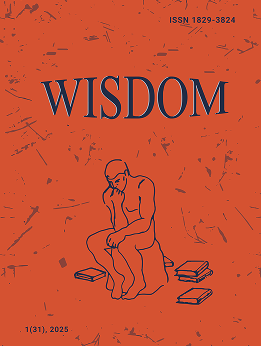The Basic Principles of Perception of Phenomena in Eastern and Western Folklore
DOI:
https://doi.org/10.24234/wisdom.v26i2.1001Keywords:
spatial perception, time perception, East, West, Western epic, “Gilgamesh and the Land of the Immortals”, “Sasna Tsrer”Abstract
The two main principles of perspective of phenomena are analyzed in the study for the first time. The epic works of European and the Near East are interpreted with the help of comparative, combinative, and historical – investigation methods.
In European heroic epics, the privilege is given to spatial dimensions, meanwhile in Eastern epics and in the Bible time recognition is more important. The spatial interpretation of the phenomena and Homer’s approach to creating the characters is spread upon the European epic works. The characters do not undergo sufficient changes in time; they go out of the process of action just the way they have gone inside.
In European works, time is a representation of some historical events and is connected with social life changes. In Eastern works the changes connect to the civilization’s long-lasting time, which refers to one’s inner world.
Downloads
References
Andersen, G. H. (2017). Polnoe sobranie skazo i istoriy v odnom tome (Complete collection of fairy tales and stories in one volume, in Russian). Moscow: Alpha Book Publishing House.
Apresyan, R. G. (2015). Dinamika obraza geroya v ìIliadeî Gomer (Dynamics of the caracter in Homerís ìIliadî, in Russian). Philosopskiy Jurnal (Philosophical Journal, in Russian), 8(4), 479-480.
Arakelyan, A. (Ed. & Trans.) (2007). Nibelungneri ergy (The song of nibelungen, in Armenian). Yerevan: Nairi.
Averintsev, S. (1971). ìGrecheskaya literature i blizhnovosochnaya slovesnostî (The Greek Literature and the Folklore of the Near East, in Russian). Voprosy Literatury (Questions of Literature, in Russian), 8, 479 pages
Biblioteca mirovoy literatury (The Library of the world literature, in Russian). (1976). ?oscow: ìVsemirnaya literaturaî.
Braudel, F. (2015). Ocherki istorii (Essays on history, in Russian). Moscow: Alma Mater.
Butler, S. (2021). Iliad. Lance Carter Publishing House
Cassirer, E. (2008). Esse mardu masin (An essay on man, in Armenian). Yerevan: Sargis Khachents ev Prinfinfo hratarakchutíyunner (Sargis Khachents and Pirntinfo Publishing Houses)
Hin arevelqi poezia (Poetry of Ancient East, in Armenian). (1982). Yerevan: Yerevan State University.
Hin Ktakaran - Joghovogh 1, Astvatsashunch (The Old Testimony, Genesis, in Armenian). (1994). Etchmiadzin: The Armenian Bible Association Publishing House.
Hovsepyan, G. (1977). Sasna Tsrer (Daredevils of Sasoun, in Armenian). (Told by Mokatsi H.). Yerevan: Soviet Writer Publishing House.
Irlandskiye legendy i skazki (Irish legends and fairy tales, in Russian). (1960). Moscow: State Publishing House of the Fiction.
Kalandzakis, S. (2020). Hin Ktakarani neratsut'yun (Introduction to ìNew Testamentî, in Armenian). St. Etchimadzin: Mayr Ator Surb Etchmiadzin hratarakchutíyun (Mayr Ator St. Etchmiadzin Publishing House, in Armenian)
Kant, I. (2006). Zut banakan qnnatatutíyun (Critique of pure reason, in Armenian). Yerevan: Sagris Khachents Publishing House.
MenÈndez Pidal, R. (1959). La chanson de Roland. Espasa-Calpe, S. A. Madrid,
Mify Narodov Mira (Myths of the world nations, in Russian). (1980). Moscow: ìSovetskaya Enciclopediaî.
Movsisyan, A. (1992). Hnaguyn petutíyuny Hayots (The ancient history of the Armenian people, in Armenian). Yerevan: Zangak.
Poezia i proza drevnego vostoka (Poetry and prose of the Ancient East, in Russian). (1973). Moscow: ìKhudozhestvennaya literaturaî.
Rohr, R., & Martos, J. (2002). Velikie temy pisaniya (Great themes of scripture, in Russian). Moscow: St. Andrewís Biblical Theological Institute.
Sasna Tsrer. Haykakan azgayin epos (Daredevils of Sasoun, the Armenian National Novel, in Armenian). (1977). Yerevan: ìSovetakan grox hratarakchutyunî.
Sasna tun (The House of Sasoun, in Armenian) (1951). In Sasna Tsrer (Daredevils of Sasoun, in Armenian) (Vol. B, Part 2). Yerevan: Haypethrat Publication.
Shekoyan, A. (2008). Sasna Tsrer, Haykakan azgayin epos (Daredevils of Sasoun, Armenian National Epic, in Armenian). Yerevan: Edit Print.
Spengler, O. (2007). Zakat zapagnogo mira (The Decline of the West, in Russian). Moscow: Academic Project Publishing House.
Stefonovich, V. (1987). Serbskiye narodnire pesni i skazki (Serbian national songs and fairy-tales, in Russian). Moscow: Fiction.
Tresidder, J. (2005). Slovar simvolov (The dictionary of the meanings, in Russian). Moscow: Vologda Regional Universal Scientific Library.
Downloads
Published
How to Cite
Issue
Section
License
Copyright (c) 2023 Ani Nazaryan; Vachagan Grigoryan , Ara Arakelyan , Naira Iskandaryan

This work is licensed under a Creative Commons Attribution-NonCommercial 4.0 International License.
Creative Commons Attribution-Non-Commercial (CC BY-NC). CC BY-NC allows users to copy and distribute the article, provided this is not done for commercial purposes. The users may adapt – remix, transform, and build upon the material giving appropriate credit, and providing a link to the license. The full details of the license are available at https://creativecommons.org/licenses/by-nc/4.0/.















